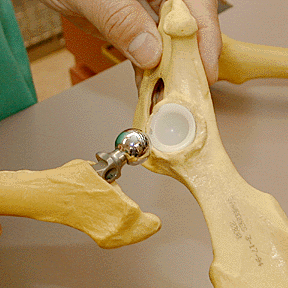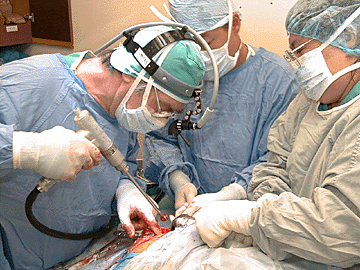


Lucky dog!
Small pets get
hip implants
One couple delays wife's
By Helen Altonn
eye surgery so pet can
get operation
Star-BulletinTabi could hardly walk into the animal clinic, and now he's jumping and running.
A recent medical advance and his owner's sacrifice have given the 7-year-old dog a life without pain.
Marge Kashiwada postponed laser eye surgery so Tabi could have a diseased hip replaced.
"It was worth it," she said, as she and her husband, Al, watched their frisky mixed-breed during a recent checkup at Kahala Pet Hospital.
"He's sure a happy dog," said veterinarian Patrick A. Leadbeater, who did a total hip replacement on Tabi on Feb. 2.

Although Leadbeater has performed the procedure for several years on larger dogs, he said implants only recently became available for smaller sizes.He asked Bio-Medtrix, which makes implants, to manufacture one for a small canine patient last August. The New York company then started producing them on a regular basis, he said.
Femoral stems and artificial sockets now may be obtained for dogs down to about 28 to 30 pounds, Leadbeater said.
In a letter to his colleagues offering information about the development, he said: "Although cost can be a factor, owners must have an opportunity to choose. In most cases, owners elect hip replacement rather than long-term medication."

The procedure has a 95 percent success rate, Leadbeater said. "It really is the answer to hip disease. Anything else is a compromise."Tabi was Leadbeater's third patient for the smaller implant.
The Kashiwadas noticed in early November that their dog was limping. They thought it might be due to arthritis or possibly an injury since he's an indoor-outdoor dog, Marge Kashiwada said.
When he didn't improve, the Pearl City couple took him to a veterinarian in their area, and he was put on medications.
"If anything, they helped minimally," Marge Kashiwada said. She asked if there were any other options and was referred to Leadbeater.
She had been saving money for laser eye surgery to improve her vision but gave that up, at least for now, to pay for Tabi's surgery.
Hip dysplasia
Hip dysplasia is a painful, progressive degeneration of one or both hip joints. About 80 percent to 85 percent of cases occur in larger dogs, but the disease affects all breeds.It can be diagnosed positively only by X-ray. Once degeneration and arthritis have developed, a hip replacement may be the only procedure to produce a pain-free, functioning joint for the rest of a pet's life
Your dog may have hip pain if it:
Is slow to get up, especially after exercise.
Plays only for short periods and then prefers to lie down.
Sways its hindquarter when walking, which is observed best as the pet walks away from you.
Strides normally on its fore legs when running but bounces on its hind legs (a gait called "bunny hopping").
Source: Kahala Pet Hospital
"I think I'd do almost anything for him," she said. "We have no grandchildren, so this is like a substitute."
When they visited Tabi the day after the surgery, she said, "we were flabbergasted. We thought somebody would carry him in, and he walked in."

Leadbeater said Tabi seemed puzzled for a week or so, but he had good range of motion and no detectable pain."He has no defects at all. At five weeks (after such surgery), you and I probably would go for physiotherapy."
Although it's a major operation, he said dogs recover rapidly.

It's more a matter of them "getting used to the feel of things" than healing, he said. "Only one muscle is partly cut in the whole procedure, and not all the way through."Al Kashiwada said he turned his head for just a couple of seconds while baby-sitting the recuperating dog, and Tabi jumped up on the sofa.
"They want to do more than we want them to," said Leadbeater.
The dog's activities must be controlled for two months after surgery, he said. "After two months he should be able to do anything, and more."
Instead of high doses of medication, he said the implant should give Tabi "a pain-free, functional joint for the rest of his life."
Leadbeater said he had a five-member team for the surgery, which takes two to three hours. "It's a fairly complex procedure. There are a lot of fine areas to take into account that are fairly demanding."
The procedure involves constant monitoring and all the safety precautions used for human surgery, he said.
"Just the instrumentation is a horrendous kind of thing, too," he said. The instruments are so expensive to buy that he rents them from a company for every case, he said.
The day before, the operating room is stripped down and the walls, lights and all equipment scrubbed, disinfected and sealed until the procedure, he said.
"It's a fairly major job. We call it a military operation," he said, noting "one chink in sterility" could cause post-surgical infection.